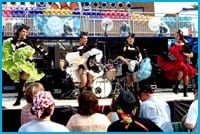You can’t please all the people all the time. In this third installment in our series on the future of Pride we tackle entertainment — the singers, bands, DJs, drag acts and other performers who take centre stage on the seven or so outdoor stages and performance areas over the Pride weekend.
Pride Toronto does a good job on entertainment, programming an incredible number and variety of acts with broad appeal. It has avoided the pitfalls that bedevil other Prides where entertainment stages symbolize the divisions in the community with separate women’s stages, men’s stages, black stages, trans stages, Latin stages and so on. Toronto, instead, mixes up women’s and men’s events and artists of various backgrounds and genres on both the Dyke March Saturday and Pride Parade Sunday. And the niche stages, the alterna stage and youth stage by Buddies and the Blockorama dance area, seem very much a part of the whole mix.
But Pride Toronto’s relative success has bred complacency. The entertainment follows a tried-and-true formula at the expense of surprise. Where is the wow factor?
The first time DJ Zahra and her Funk-asia cohorts closed the main South Stage on the final day of Pride, it was delirious delight — a South Asian Muslim dyke exhorting a huge dancing crowd to feel the love as a bevy of boys in colourful outfits gyrated onstage — it all made the spectators feel as if they were are part of something special, something we could only enjoy in Toronto. But then Pride brought her back four years in a row. While Zahra still puts on a show like no other, the energy, the surprise, the “wow” factor the fourth-time running was not the same.
Pride Toronto needs to keep shaking things up. They need to take risks. They need to keep surprising us.
That doesn’t necessarily mean bringing in marquee names from outside of Toronto; Pride Toronto can’t really afford it and they don’t need to since Toronto is home to many good and great acts. No one is going to agree on whom to program. There’s just too many choices and tastes. Instead of focussing on whom to program over Pride weekend, we thought we’d suggest some improvements on how to program.
1) Keep dead time on the stages to a minimum and avoid those moments between live acts when crews are setting up or when nothing at all is happening.
How many times have you been caught in that unfortunate back-and-forth stroll along Church in a fruitless search for entertainment? You finally make your way down to the big South Stage only to find that either nothing’s happening or you don’t like the act that’s playing, so you make the long trek up to the North Stage just in time to see another act leaving the stage. Back and forth you bounce and you never see anything.
Wouldn’t combining DJs and live acts on one stage help get rid of those dead times?
Programmers should move away from entertainment slots that are an hour or less in duration, in favour of longer chunks of time, two to four hours. Continuous shows over longer periods can build momentum and keep us happy and hanging around. Crafting an entire afternoon or evening’s entertainment is the stuff of experienced party promoters. Which brings us to the next suggestion….
2) Find someway to better tap into the expertise of party promoters in town. Why not give over whole two- or three-hour slots at various stages to people like Will Munro, Gairy Brown, Denise Benson, Steven Ireson, the Big Primpin’ crew and other folks with a proven track record on how to entertain us, folks who know how to mix live acts and DJs.
There must be someway for Pride and Toronto’s promoters to partner up that makes sense for everyone concerned. Granted, Pride Toronto must be gun-shy after the Pride Ball debacle two years ago. But that was supposed to be a money-making venture. There must be other models of cooperation. Couldn’t a stint running a Pride stage be seen as a big advertisement for the promoter’s own off-site party later that night?
Perhaps Pride Toronto’s role could shift over time, becoming more of an umbrella group that markets and coordinates rather than programs.
3) In addition to promoters, there are arty folks in town who know how to transform crowds of spectators into active participants. How cool would it be if, say, Toronto Dance Theatre and The Hidden Cameras remounted one of their recent collaborative productions on a Pride stage. These shows are all about breaking down the barriers between performer and audience. Very sexy, very fun.
Why not take that concept offstage and hire artists-in-residence who would create installations or pop-up performances everywhere on the Pride grounds. Sasha Van Bon Bon and friends did hilarious performances on the street on their own (that is, no one hired them) last Halloween.
Entertainment during Pride is not about attracting more tourists but enticing us to be in the moment and an active part of a collective celebration. It’s a tribal dance; please don’t stop the music.


 Why you can trust Xtra
Why you can trust Xtra


